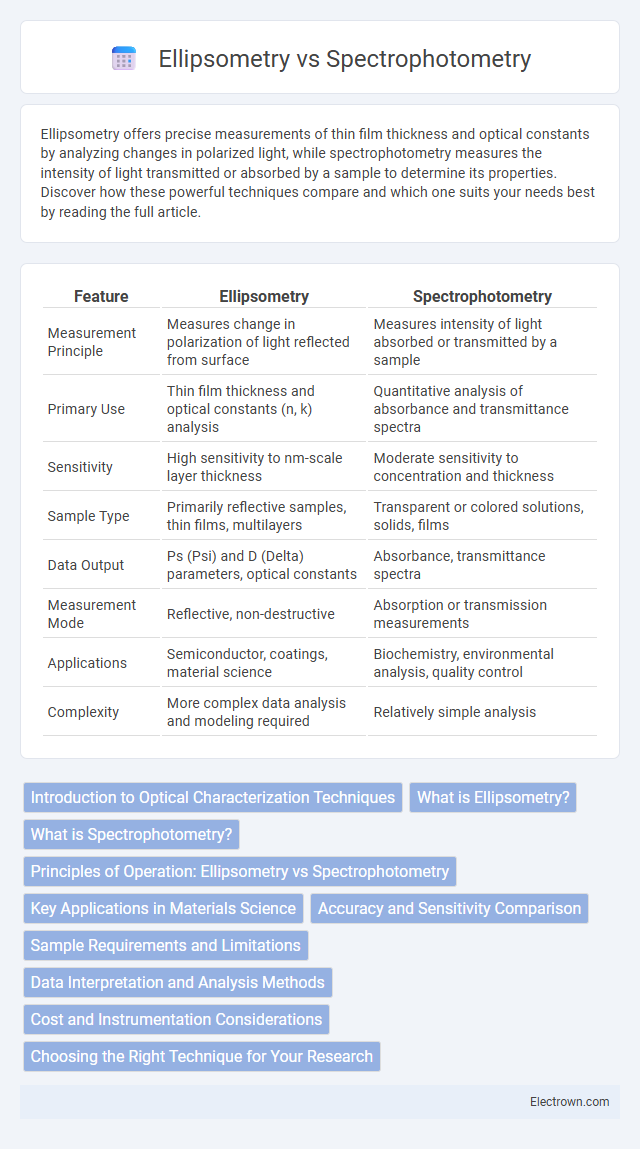Ellipsometry offers precise measurements of thin film thickness and optical constants by analyzing changes in polarized light, while spectrophotometry measures the intensity of light transmitted or absorbed by a sample to determine its properties. Discover how these powerful techniques compare and which one suits your needs best by reading the full article.
Table of Comparison
| Feature | Ellipsometry | Spectrophotometry |
|---|---|---|
| Measurement Principle | Measures change in polarization of light reflected from surface | Measures intensity of light absorbed or transmitted by a sample |
| Primary Use | Thin film thickness and optical constants (n, k) analysis | Quantitative analysis of absorbance and transmittance spectra |
| Sensitivity | High sensitivity to nm-scale layer thickness | Moderate sensitivity to concentration and thickness |
| Sample Type | Primarily reflective samples, thin films, multilayers | Transparent or colored solutions, solids, films |
| Data Output | Ps (Psi) and D (Delta) parameters, optical constants | Absorbance, transmittance spectra |
| Measurement Mode | Reflective, non-destructive | Absorption or transmission measurements |
| Applications | Semiconductor, coatings, material science | Biochemistry, environmental analysis, quality control |
| Complexity | More complex data analysis and modeling required | Relatively simple analysis |
Introduction to Optical Characterization Techniques
Ellipsometry measures changes in polarization upon reflection or transmission, providing precise thickness and refractive index data for thin films, whereas spectrophotometry quantifies light absorption or transmission across wavelengths to determine material properties. Both techniques are essential in optical characterization, with ellipsometry excelling in nanoscale film analysis and spectrophotometry widely used for bulk material assessment. Understanding their complementary strengths enhances comprehensive evaluation of optical materials.
What is Ellipsometry?
Ellipsometry is an advanced optical technique used to measure the thickness and optical properties of thin films by analyzing the change in polarization as light reflects off a sample surface. It provides highly sensitive, non-destructive measurements essential for semiconductor manufacturing, material science, and nanotechnology applications. Your ability to precisely determine film thickness and refractive index with ellipsometry surpasses the limitations of conventional spectrophotometry, especially for ultra-thin or multi-layered materials.
What is Spectrophotometry?
Spectrophotometry is an analytical technique that measures the intensity of light absorbed by a sample at different wavelengths to determine its concentration and chemical composition. It operates by passing a specific spectrum of light through the sample and detecting the amount of light transmitted or absorbed, providing quantitative and qualitative information about the material. Widely used in chemistry and biochemistry, spectrophotometry enables precise analysis of liquids, solids, and gases based on their light absorption properties.
Principles of Operation: Ellipsometry vs Spectrophotometry
Ellipsometry measures the change in polarization state of light reflected from a sample to determine thin film thickness and optical properties with high precision. Spectrophotometry quantifies the intensity of light absorbed or transmitted through a sample across various wavelengths to analyze concentration and chemical composition. Your choice depends on whether you need detailed surface characterization (ellipsometry) or bulk material analysis (spectrophotometry).
Key Applications in Materials Science
Ellipsometry excels in characterizing thin film thickness, optical constants, and complex refractive indices, making it indispensable for semiconductor development and surface coating analysis. Spectrophotometry is widely used to measure absorbance and transmittance, providing critical data on material composition, concentration, and optical properties in polymers and biological samples. Your choice depends on whether detailed surface property analysis or bulk optical characterization is required for materials science applications.
Accuracy and Sensitivity Comparison
Ellipsometry offers higher accuracy and sensitivity than spectrophotometry by measuring changes in light polarization upon reflection, enabling precise determination of thin film thickness and refractive index. Spectrophotometry relies on intensity measurements of transmitted or reflected light, which can be less sensitive to subtle variations in optical properties. Ellipsometry's ability to detect sub-nanometer thickness changes and minute refractive index differences makes it more suitable for advanced materials characterization.
Sample Requirements and Limitations
Ellipsometry requires smooth, flat, and reflective samples for accurate measurement of thin film thickness and optical constants, making it unsuitable for rough or highly scattering surfaces. Spectrophotometry accommodates a wider variety of samples, including liquids, powders, and rough solids, but often provides less detailed information on layer thickness and refractive index compared to ellipsometry. Limitations of ellipsometry include sensitivity to surface roughness and transparent substrates, while spectrophotometry is limited by its lower sensitivity to subtle film properties and interference effects.
Data Interpretation and Analysis Methods
Ellipsometry measures the change in polarization as light reflects off a surface, providing complex data about film thickness and refractive index through modeling and fitting algorithms. Spectrophotometry records light intensity at various wavelengths, requiring absorbance or transmittance spectra analysis to determine concentration or material properties using Beer-Lambert law and calibration curves. Ellipsometry's data interpretation involves more advanced mathematical models and inversion techniques, whereas spectrophotometry relies on more straightforward numerical analysis and empirical correlations.
Cost and Instrumentation Considerations
Ellipsometry generally involves higher initial costs due to its sophisticated instrumentation, including polarized light sources and precise detectors, compared to spectrophotometry, which uses simpler components like light sources and monochromators. The complex data analysis in ellipsometry requires advanced software and skilled operators, making it a more expensive choice for detailed thin-film measurements. Your decision should weigh the budget constraints and the level of material characterization needed to determine the most cost-effective option.
Choosing the Right Technique for Your Research
Ellipsometry offers precise measurement of thin film thickness and optical constants by analyzing polarization changes, making it ideal for nanometer-scale layer characterization in materials science. Spectrophotometry excels in quantifying absorbance and transmittance over broad wavelength ranges, providing valuable data for chemical composition and concentration analysis. Selecting between ellipsometry and spectrophotometry depends on research goals: prioritize ellipsometry for detailed thin film analysis and spectrophotometry for bulk material optical properties.
Ellipsometry vs Spectrophotometry Infographic

 electrown.com
electrown.com